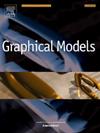VolumeDiffusion: Feed-forward text-to-3D generation with efficient volumetric encoder
IF 2.2
4区 计算机科学
Q2 COMPUTER SCIENCE, SOFTWARE ENGINEERING
引用次数: 0
Abstract
This work presents VolumeDiffusion, a novel feed-forward text-to-3D generation framework that directly synthesizes 3D objects from textual descriptions. It bypasses the conventional score distillation loss based or text-to-image-to-3D approaches. To scale up the training data for the diffusion model, a novel 3D volumetric encoder is developed to efficiently acquire feature volumes from multi-view images. The 3D volumes are then trained on a diffusion model for text-to-3D generation using a 3D U-Net. This research further addresses the challenges of inaccurate object captions and high-dimensional feature volumes. The proposed model, trained on the public Objaverse dataset, demonstrates promising outcomes in producing diverse and recognizable samples from text prompts. Notably, it empowers finer control over object part characteristics through textual cues, fostering model creativity by seamlessly combining multiple concepts within a single object. This research significantly contributes to the progress of 3D generation by introducing an efficient, flexible, and scalable representation methodology.

VolumeDiffusion:前馈文本到3d生成与高效的体积编码器
这项工作提出了VolumeDiffusion,一个新的前馈文本到3D生成框架,直接从文本描述合成3D对象。它绕过了传统的基于分数蒸馏损失或文本到图像到3d的方法。为了扩大扩散模型的训练数据,开发了一种新的三维体积编码器,以有效地从多视图图像中获取特征体积。然后使用3D U-Net在文本到3D生成的扩散模型上训练3D体。该研究进一步解决了不准确的目标标题和高维特征量的挑战。该模型在公共Objaverse数据集上进行了训练,在从文本提示生成多样化和可识别的样本方面展示了有希望的结果。值得注意的是,它可以通过文本线索更好地控制对象部分特征,通过在单个对象中无缝地组合多个概念来培养模型创造力。该研究通过引入一种高效、灵活、可扩展的表示方法,对三维生成的进展做出了重大贡献。
本文章由计算机程序翻译,如有差异,请以英文原文为准。
求助全文
约1分钟内获得全文
求助全文
来源期刊

Graphical Models
工程技术-计算机:软件工程
CiteScore
3.60
自引率
5.90%
发文量
15
审稿时长
47 days
期刊介绍:
Graphical Models is recognized internationally as a highly rated, top tier journal and is focused on the creation, geometric processing, animation, and visualization of graphical models and on their applications in engineering, science, culture, and entertainment. GMOD provides its readers with thoroughly reviewed and carefully selected papers that disseminate exciting innovations, that teach rigorous theoretical foundations, that propose robust and efficient solutions, or that describe ambitious systems or applications in a variety of topics.
We invite papers in five categories: research (contributions of novel theoretical or practical approaches or solutions), survey (opinionated views of the state-of-the-art and challenges in a specific topic), system (the architecture and implementation details of an innovative architecture for a complete system that supports model/animation design, acquisition, analysis, visualization?), application (description of a novel application of know techniques and evaluation of its impact), or lecture (an elegant and inspiring perspective on previously published results that clarifies them and teaches them in a new way).
GMOD offers its authors an accelerated review, feedback from experts in the field, immediate online publication of accepted papers, no restriction on color and length (when justified by the content) in the online version, and a broad promotion of published papers. A prestigious group of editors selected from among the premier international researchers in their fields oversees the review process.
 求助内容:
求助内容: 应助结果提醒方式:
应助结果提醒方式:


